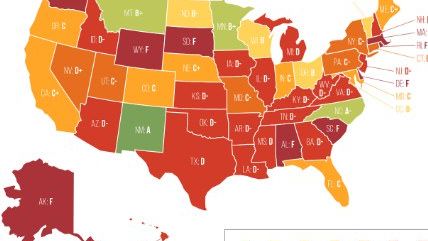This Map Details Whether Asset Forfeiture Laws in Your State Are Good or Awful
(Spoiler: Chances are they're probably awful.)

The liberty-loving activists at FreedomWorks has produced a useful tool to examine the quality of civil asset forfeiture laws (the rules that allow police to seize and often keep money and property from busts) across the states. They've put together a new map that grades each state and the federal government on the basis of the following questions:
- What is the standard of proof the government must meet to forfeit a person's property?
- Who has the burden of prove innocence or mistake—the government or the property owner?
- What percentage of forfeiture funds are retained by law enforcement?
In case it's not immediately clear, the best states would be ones that require the highest standards of proof of criminal behavior (beyond reasonable doubt) for seizure, states that require the government prove the property was involved in crimes rather than the citizen having to prove innocence, and states where law enforcement retains less (or none) of the forfeited funds, thereby avoiding economic incentives to abuse the system.
As the map below shows, very few states can proudly declare that they've put their citizenry first in the creation of their asset forfeiture laws (click the map for a larger picture):

Note that the top grade goes to New Mexico, which recently passed massive reforms to its civil asset forfeiture rules. They are the only full "A" grade on the map. FreedomWorks' full report explaining each state's grade notes:
The Legislature recently passed reforms and they were signed into law by Governor Martinez. The state now requires a criminal conviction before property can be forfeited and all forfeiture funds now go directly to the state's general fund. Additionally, state and local law enforcement are prohibited from sending seized property to the federal government for "equitable sharing," where they would receive up to 80% of the proceeds.
The only other state on the top of grade chart is North Carolina, which earned an A-. They don't get full credit because the state puts the burden of proof on the property owner to prove his or her innocence. After that, the grades start going downhill very quickly. Only a handful of states (and the District of Columbia) get B's, and the rest are all C's or lower.
FreedomWorks also grades the federal asset forfeiture system and gives it a dreadful D-, something people should keep in mind whenever they think the Department of Justice can fix whatever ails our local law enforcement agencies. The standard of proof for federal asset seizure is low, the property owner bears all the burden of proving innocence, and the feds can keep it all. The "Equitable Sharing Program" allows state and municipal law enforcement agencies to "partner" with federal agencies for busts, allowing (even encouraging) local agencies to bypass whatever restrictions states put into place to cash in on this D- system and keep 80 percent of what they seize. New Mexico's new regulations forbid the law enforcement agencies in the state from participating in this system. California is now poised to possibly do the same. Michigan is working on a package of reforms that don't go nearly as far.
An important note on these grades: The state grades do not take into account whether law enforcement agencies bypass the state laws and use the Department of Justice's program. The Institute for Justice, the legal activists who also help fight for forfeiture reform, had their own set of grades they produced back in 2010. North Carolina, for example, got a lower grade (a C+) because law enforcement agencies would get millions in proceeds from asset forfeiture from the federal government, even though the state itself does not let police keep what they seize.
Below the fold, the full FreedomWorks report is embedded.


Show Comments (50)